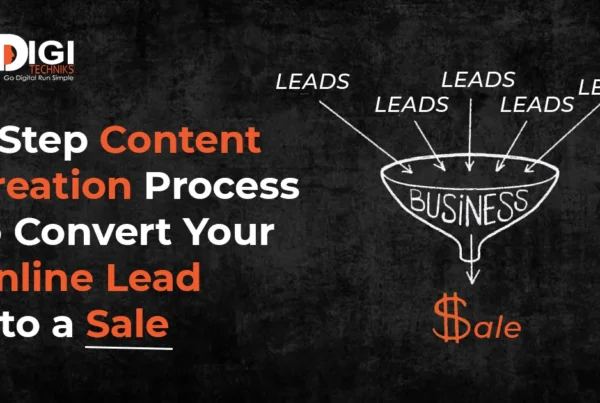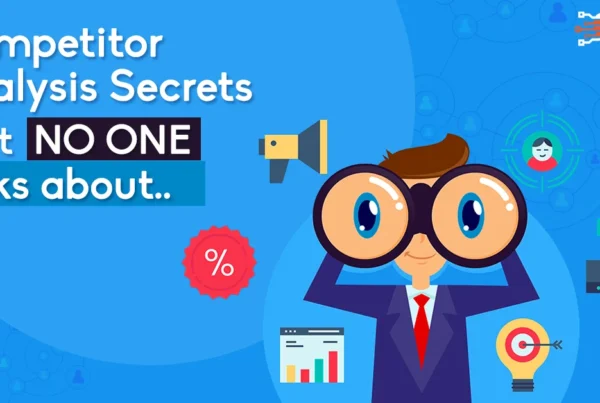
According to statistics, 8 out of 10 entrepreneurs fail within the first 18 months of starting their business — that’s a shocking 80% fail rate!
And, it’s not just about small businesses and startups. The history of business is riddled with the cautionary tales of big brands and huge corporations that went bust or shut shop.
But, failure is not what we’re here to talk about. So, let’s shift our focus to the other 20%. What are they doing right that makes them successful? How can your business join the winning camp?
One of the biggest reasons why so many companies, small and big, fail to grow is because they do not fully understand the business they are in.
For example, if I were to ask you, how well do your know your competitors and the buying patterns of your consumers, would you be able to answer confidently?
If yes, great — you’re on the right path!
If no, you’ve got some work to do if you wish to succeed.
Enlighten Yourself with the Strength of Business Knowledge
A stable, well-performing business cannot be built by guesswork or purely on the basis of intuition. Every step, key decisions or investment hinges on you having full and in-depth understanding of your core business and industry.
So, to help you acquire this knowledge, I’m going to walk your through the steps that will show you how to understand your business. And, in the process, I’m going to lift examples from my business to support your understanding.
Step 1: Tell your story — How your business got started
Often, in the rush of events and in our struggles to compete, we forget to remind ourselves where we started from and our true purpose for setting up a business.
So, first of all let’s go back to the roots. This is the first step towards knowing your business. To do this, ask yourself —
- What prompted you to start this business? Is there a specific reason why or a story behind it?
For example, in my experience of working in an agency, I understood that I couldn’t fulfil the promises that I was making to clients unless I had a team that could deliver on those promises. Workplace politics, poor work ethics, and other such problems made things worse. That’s when I felt the need to build my own team who can I can rely on to give my clients what they deserved. That’s how Digitechniks came to be.
That’s my story, what’s yours? When you tell your story, it helps generate empathy, intent, and inspiration, that’s what connects you with your prospects and earns you sales on a digital platform. Consider this: 80% consumers prefer brands that tell stories.
- Why did you decide to start selling what you’re selling? What burning desire or need does it fulfil?
For me, it was about recognizing the dearth of clear strategies in the digital platform. Businesses were spending lakhs on Google and Facebook ads and driving tons of traffic, but only a few were making significant conversions due to intense competition. I started helping people acquire customers at a positive digital ROI.
Now, think about what burning desire/need in the market does your product/service fulfil?
- What makes your product/service unique? Specifically, how is it better than any other option your prospect may have, including doing nothing at all?
When I entered the business training space, there was already a lot of competition in the market. What did I do to make my business stand apart from others? I chose to teach people how to develop winning strategies whereas my competitors were focused on tools. So, that was my USP. Plus, I’m offering more value for the price my clients pay. That’s helping me cut through the competition.
Think about your business from this perspective: What am I offering that no one’s offering?
Step 2: Know your challenges
Having a deep insight into your business challenges is half the battle. Remember, you’re not only competing against other businesses, but also competing to overcome your challenges.
Specifically, you should think about the drawbacks that your product/service might have and the difficulties you face during your sales process, among other challenges.
Here are the questions you should ask yourself at this stage —
- Are there any drawbacks to your service or product?
Knowing your weaknesses and addressing them early on is key to building a sustainable business.
So, if you ask me, that’s exactly what I did. I identified the drawbacks in my business — there was no one-to-one involvement and my solutions were not customized to my clients’ businesses. Once I was able to recognize these issues, I fixed them. Now I have specialized teams that cater to specific industries and I’m on my way to building a separate team for B2B businesses.
What are the current limitations or shortcomings of your product/service offerings? What can you do to eliminate them?
- As a follow-up to the previous question, are there any common objections that come up during the sales process?
Prospective clients would ask me this question very often: Have you done any similar types of projects? — They wanted to see the work my team has done on a business similar to theirs. With developing industry specific teams, I was able to sort this issue as well.
So, think about the questions that you encounter repeatedly from clients and how well you’re able to answer them. If you struggle to answer any of those questions, consider that as an area of improvement.
- What will a prospect lose if they don’t take action now?
My clients witness a steady growth in leads, sales, and business. So, if a prospect doesn’t take action, those are the benefits they stand to lose.
What would your prospects miss out on if they didn’t opt for your product/service?
Step 3: Understand your target demographics
The better your understanding of who your ideal customer is, the more targeted and laser-focused your strategies will be. With enhanced customer knowledge comes more qualified sales opportunities with higher chances of conversions. And the more you sell, the better your business will grow.
At this stage, you must ask these questions —
- What’s your target demographic?
Identify your target customer’s age, income level, gender, occupation, etc. The more information, the better.
- What are their top three fears related to your niche?
In other words, what keeps your prospects up at night? Customer understanding goes beyond your target demographics. To get to the core of your customers, it’s important to ask this question.
In my case, the biggest fear of my target audience is losing money because they don’t have clarity on the why’s and how’s of a particular strategy. So, they fear what if they lose all the money they have invested on Google and FB ads; they fear not getting positive ROI; and they fear not getting enough leads to make more sales.
- How does your product/service address those fears?
I mostly write my blogs around the fears of my prospects and provide them actionable guidance to overcome these fears. I offer strategies and I also offer the understanding of how those strategies work so it can generate positive digital ROI for them.
Think about how your offerings can solve your customers’ fears.
Step 4: Understand the results you’re capable of generating
“And often, people aren’t interested in buying a product or service. They’re interested in the benefit that comes from buying, not the product or service itself.”
So, the questions to think about at this step are —
- What sort of results do your clients see as a result of using your service?
- If you could wave a magic wand and give your clients an ideal result from using your service, what would it be?
- If you had 30 seconds to explain what you do and why it can help a prospect reach their goals, what would that look like? (AKA: Your elevator pitch.)
This is where you need to think the actual benefits that you have provided to your clients in the past. This will help you create the right content and strengthen the marketing message of your business.
In my case, I can generate 1000 leads in 60 days for clients who take my lead generation services. In fact, for every real estate company that can pay 1 Lakh rupees, I can give them 1000 leads in 30 days for no additional cost — that’s a guarantee I offer. Similarly, if a client takes my Google ads service, I promise to keep them in the top three spots on search results for 24 hours a day.
And, that’s my quick and effective 30 seconds pitch. I don’t beat around the bush; rather, I talk directly about results in numbers. Plus, I have proof in the form of results that I’m already generating for my clients to back up my claims.
So my tips for you are:
- Think of the most hard-hitting results that you can deliver for your client.
- Give them a test run and see if you can realistically generate those results.
- If yes, use it as your 30-secs pitch that will impress your prospects.
- Back up your claim with a proof of results you’ve been able to generate.
- Can you list your biggest competitors?
Knowing who your competitors are allows you to replicate their successes and avoid their blunders. You can learn from their strengths and take advantage of their weaknesses to elevate your business performance.
Now, there are two types of competitors — direct and indirect. Let me explain with examples.
For me, my biggest offering is one-to-one mentorship, which no one is offering in my target market as of yet. So, I don’t have a direct competitor.
My major indirect competitors are companies and individuals offering business coaching and digital marketing training. Our service areas don’t exactly overlap but they are targeting the same audience that I’m targeting.
So, to sum it up:
Your indirect competitors are businesses that are targeting similar audience as you are and they claim to solve the problems that you’re claiming to solve but through a different product/service offering.
Your direct competitors are those that target the same audience and address the same problems, and also provide the same product/service as yours.
You can use a tool called Alexa to help you in the process of shortlisting and analyzing your top-level competitors. If you’re a startup, you should also consider looking at other successful startups and new businesses that are making their mark. You can then closely follow the tactics and strategies that are contributing to their success.
We dive into the details of how to identify direct/indirect competitors, steps to do competitor analysis, and the tools that can help you do it in another post.
Step 5: Business Intelligence
As saying goes — you can’t manage what you don’t measure. In business, number crunching is a critical exercise and one that’s absolutely indispensable I you wish to know your business better.
This is where metrics like total revenue, profit margin, customer lifetime value (CLTV) etc. come in. Without knowing these, you’ll be left in the dark when it comes to making productive changes in your business.
This is the step to asking yourself these questions:
- What’s your current revenue per year? What’s your profit margin?
- What is your average customer lifetime value? (Hint: CLTV measures the profit your business can make from any given customer. So, CLTV = Amount of new revenue you collect in 6 months / no. of new customers you gained in the last 6 months.)
- What is your business website? Which are your best selling products or services?
- What does your marketing funnel look like (if any)? What does your current marketing strategy look like?
- What have you tried that failed in the past? Why do you think it didn’t work?
Crack the Code to Your Business Success
The process of knowing your business often involves asking yourself questions you might have never asked before. But you must be authentic and true to yourself when answering these questions.
For more guidance, join our Digital Media Strategy and Planning Mentorship Program, which will empower you with the tips, tricks, and tools you need to get to the bottom of your business and understand it inside and out.
It enables you to decide what works best for your company and even goes a step ahead to help you determine whether you are dealing with authentic business entities and ethics or not.
Sign up for 2 hours of training session worth only ₹499 and get access to all our business intelligence and inspiration templates that will help you ace your game in today’s changing business environment.
Do you want to get a personalised 1-to-1 discovery session?
Book your 1-to-1 discovery call with us today!
FAQs
1. Why is business clarity important before marketing?
Without clarity on your audience, offer, and positioning, even the best marketing campaigns fail. Clarity ensures you target the right people with the right message.
2. What are the signs that I don’t truly understand my business?
Some signs include inconsistent messaging, poor lead quality, misaligned team efforts, and difficulty scaling revenue.
3. How do I self-assess my business clarity?
You can use our Business Clarity Worksheet to audit your goals, audience personas, core value proposition, and customer journey.
4. Can this framework apply to service-based and product-based businesses?
Yes, the principles of business clarity and self-diagnosis apply across both service and product-based models with slight adjustments.



